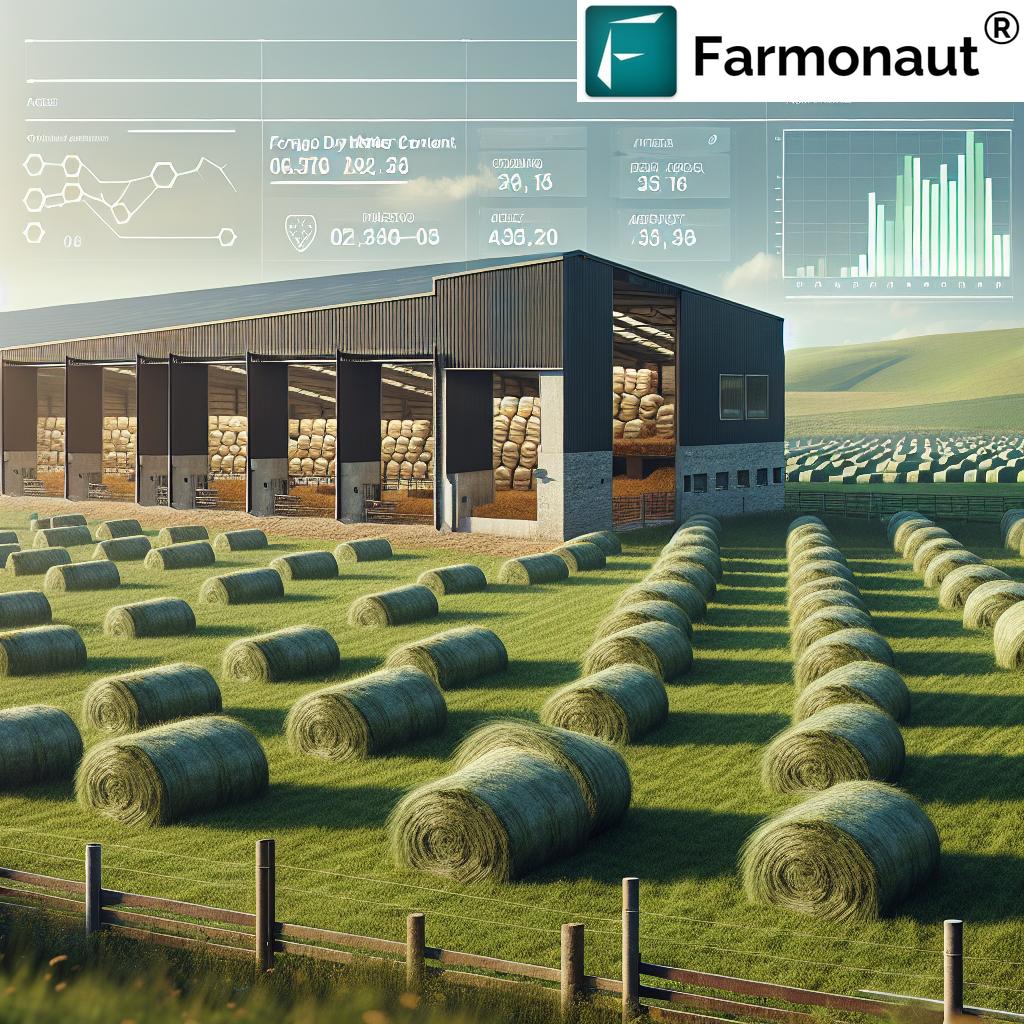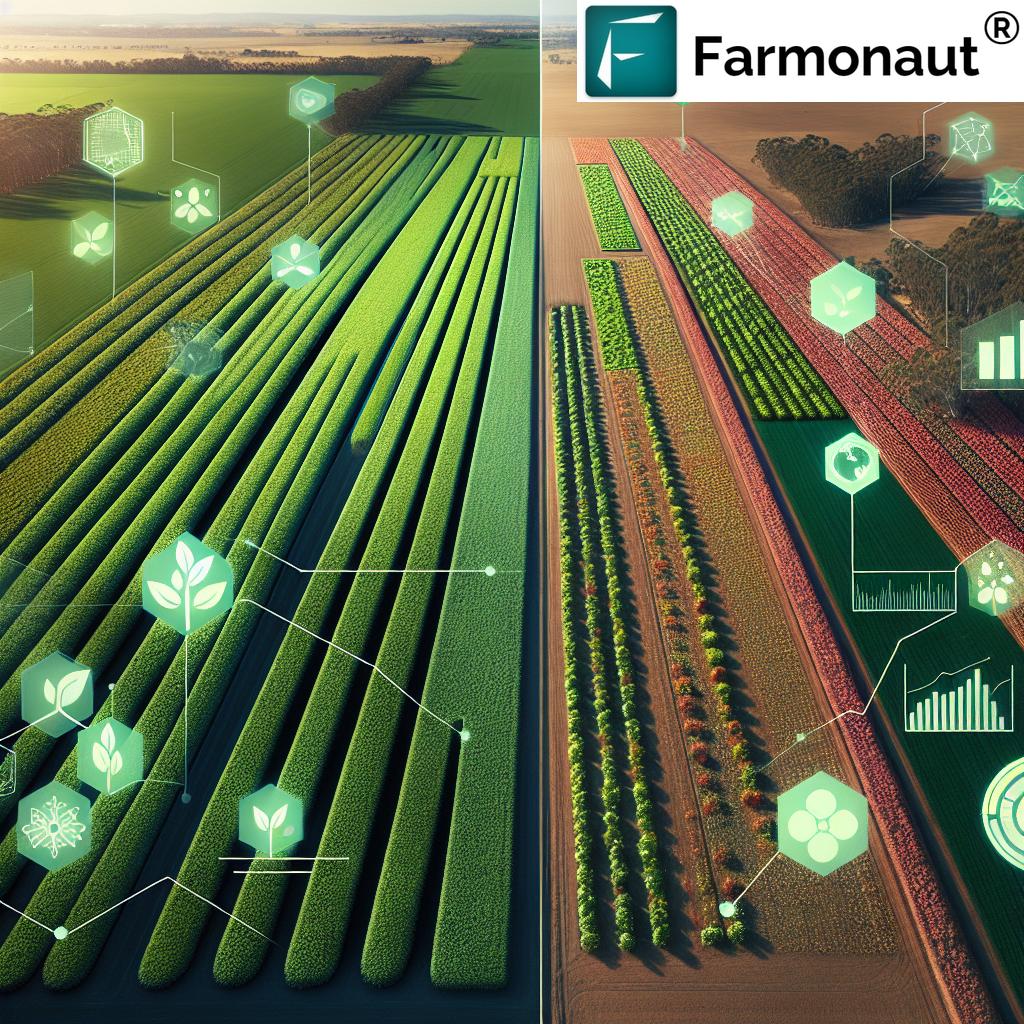Melbourne Wool Market Reopens Strong: 2024 Trends and Agtech Insights for Australian Farmers
“Melbourne’s wool market reopening saw medium wool demand surge, with prices for superior clips increasing up to 5% in 2024.”
Welcome to our comprehensive analysis of the Australian wool market’s reopening in Melbourne and the exciting trends shaping the industry in 2024. As we delve into this topic, we’ll explore the surprising strength of the market, the resilience of agricultural commodity prices, and the valuable insights that Farmonaut’s advanced agtech solutions can offer to wool producers navigating these dynamic market conditions.
The Resilient Reopening of Melbourne’s Wool Market
The Australian wool market’s recent reopening in Melbourne has caught the attention of farmers, buyers, and industry experts alike. Despite initial concerns about potential market volatility, the reopening has showcased remarkable resilience, particularly in the realm of agricultural commodity prices. This positive start to 2024 has injected a sense of optimism into the rural community and agricultural businesses across the state.

One of the most notable aspects of this market reopening has been the surge in demand for medium wools. This unexpected development has pleasantly surprised many in the industry, indicating positive market trends for 2024. The increased interest in medium wools suggests a shift in buyer preferences and potentially signals new opportunities for wool producers who specialize in these categories.
Analyzing Wool Market Trends 2024
As we dive deeper into the wool market trends for 2024, it’s crucial to understand the various factors influencing prices and demand across different wool categories. Let’s break down the key elements shaping the market landscape:
- Medium Wool Demand: The unexpected surge in medium wool demand has been a standout feature of the market reopening. This trend could be attributed to changing consumer preferences or shifts in manufacturing needs.
- Fine Wool Challenges: While medium wools have seen a boost, finer wools are facing some challenges. These difficulties could be related to oversupply, changes in global fashion trends, or economic factors affecting luxury markets.
- Quality Assessment: Overall wool quality assessment has revealed steady to slightly increased prices for superior clips. This trend underscores the importance of maintaining high-quality wool production to secure better prices in the market.
- Export Potential: Australian wool exports continue to play a crucial role in the global textile industry. The market reopening provides valuable insights into the export potential for different wool categories in 2024.
To better understand these trends, let’s take a look at a detailed breakdown of wool market performance by micron category:
| Micron Category | Price Change (%) | Current Demand Level | Quality Assessment | Export Potential |
|---|---|---|---|---|
| Superfine (≤18.5µ) | -2% | Medium | Excellent | High |
| Fine (18.6µ-20.5µ) | 0% | Medium | Good | Medium |
| Medium (20.6µ-22.5µ) | +5% | High | Good | High |
| Strong (22.6µ-24.5µ) | +3% | Medium | Average | Medium |
| Extra Strong (>24.5µ) | +1% | Low | Average | Low |
This table provides a clear overview of how different wool micron categories are performing in the current market. It’s evident that medium wools are experiencing the strongest growth, while superfine wools are facing some headwinds. This information is crucial for farmers and agribusinesses in making informed decisions about their wool production strategies.
The Role of Agtech in Optimizing Wool Production
In today’s rapidly evolving agricultural landscape, the integration of advanced technology is becoming increasingly crucial for success. This is where Farmonaut’s innovative agtech solutions come into play, offering wool producers powerful tools to navigate market fluctuations and optimize their production processes.
Farmonaut’s satellite-based farm management solutions provide real-time insights that can significantly benefit wool producers:
- Pasture Health Monitoring: By utilizing multispectral satellite imagery, farmers can assess the health of their pastures, ensuring optimal grazing conditions for their sheep.
- Weather Forecasting: Accurate weather predictions help in planning shearing schedules and protecting flocks from adverse conditions.
- Resource Management: Efficient allocation of resources like water and feed can lead to healthier sheep and higher-quality wool.
To access these powerful tools and more, consider exploring Farmonaut’s offerings:
Web App | Android App | iOS App


Sustainable Wool Farming Practices and Their Impact on Exports
As the global market increasingly values sustainability, adopting eco-friendly farming practices can significantly impact the export potential of Australian wool. Sustainable wool farming not only benefits the environment but also appeals to conscientious consumers and manufacturers worldwide.
“Australian wool supply for the 2023-24 season is projected to decrease by approximately 7%, impacting global market dynamics.”
Key sustainable practices in wool farming include:
- Rotational grazing to maintain pasture health
- Implementing water conservation techniques
- Using environmentally friendly pest control methods
- Prioritizing animal welfare in all aspects of farm management
By embracing these practices, Australian wool farmers can enhance their reputation in the global market, potentially commanding premium prices for their sustainably produced wool.
Leveraging Livestock Farming Technology for Enhanced Productivity
The integration of advanced technology in livestock farming, particularly in wool production, is revolutionizing the industry. Farmonaut’s suite of tools offers several advantages for sheep farmers looking to boost their productivity:
- Flock Management: Using satellite imagery and AI, farmers can monitor their flocks more efficiently, identifying potential health issues early.
- Pasture Optimization: Advanced analytics help in determining the best grazing patterns and pasture rotation schedules.
- Supply Chain Traceability: Blockchain-based solutions ensure transparency in the wool supply chain, adding value to the final product.
For developers and businesses looking to integrate these advanced features into their own systems, Farmonaut offers API access. Explore the possibilities at:
Farmonaut API | API Developer Docs
Adapting to Changing Market Conditions: Strategies for Australian Wool Producers
With projections of lower Australian wool supply for the 2023-24 season, farmers need to be strategic in their approach to maximize yields and adapt to changing market conditions. Here are some key strategies:
- Diversification: Consider diversifying wool micron categories to spread market risks.
- Quality Focus: Invest in practices that enhance wool quality to command better prices.
- Technology Adoption: Embrace agtech solutions like Farmonaut to improve farm efficiency and productivity.
- Market Research: Stay informed about global trends and demand patterns in the wool industry.
- Sustainable Certifications: Pursue certifications that validate sustainable farming practices to appeal to eco-conscious buyers.

The Future of Wool Production and Rural Economies
The trends we’re observing in the Melbourne wool market reopening could have far-reaching implications for the future of wool production and rural economies in Australia. As we look ahead, several key factors are likely to shape the industry:
- Technological Integration: The increasing adoption of agtech solutions will continue to drive efficiency and productivity in wool farming.
- Sustainability Focus: Growing consumer demand for sustainable products will further emphasize the importance of eco-friendly farming practices.
- Global Market Dynamics: Fluctuations in international demand and trade relationships will continue to influence Australian wool exports.
- Climate Adaptation: Farmers will need to adapt to changing climate conditions, potentially altering traditional farming calendars and practices.
Conclusion: Embracing Innovation for a Thriving Wool Industry
The strong reopening of the Melbourne wool market in 2024 signals a positive outlook for the Australian wool industry. However, to maintain this momentum and navigate future challenges, it’s crucial for farmers and industry stakeholders to embrace innovation and sustainable practices.
By leveraging advanced agtech solutions like those offered by Farmonaut, wool producers can enhance their productivity, adapt to market fluctuations, and contribute to the long-term sustainability of the industry. As we move forward, the integration of technology, focus on quality, and commitment to sustainable farming will be key drivers of success in the evolving landscape of Australian wool production.
Farmonaut Subscriptions
Frequently Asked Questions (FAQ)
- Q: What factors contributed to the strong reopening of the Melbourne wool market in 2024?
A: The strong reopening was primarily driven by increased demand for medium wools, positive agricultural commodity prices, and steady to slightly increased prices for superior quality clips. - Q: How can Farmonaut’s agtech solutions benefit wool producers?
A: Farmonaut offers satellite-based farm management tools that help monitor pasture health, provide accurate weather forecasts, and optimize resource management, all of which can lead to improved wool quality and farm productivity. - Q: What are some sustainable wool farming practices that can impact exports?
A: Key sustainable practices include rotational grazing, water conservation techniques, eco-friendly pest control, and prioritizing animal welfare. These practices can enhance the reputation of Australian wool in global markets. - Q: How is the projected decrease in Australian wool supply for 2023-24 likely to affect the market?
A: The projected 7% decrease in supply could lead to increased competition among buyers, potentially driving up prices. However, it may also encourage exploration of alternative sources or materials in the global textile industry. - Q: What strategies can Australian wool producers use to adapt to changing market conditions?
A: Key strategies include diversifying wool micron categories, focusing on quality improvement, adopting agtech solutions, conducting thorough market research, and pursuing sustainable farming certifications.
We hope this comprehensive analysis provides valuable insights into the current state and future prospects of the Australian wool market. By staying informed and leveraging innovative solutions, wool producers can navigate the challenges and opportunities that lie ahead in this dynamic industry.













